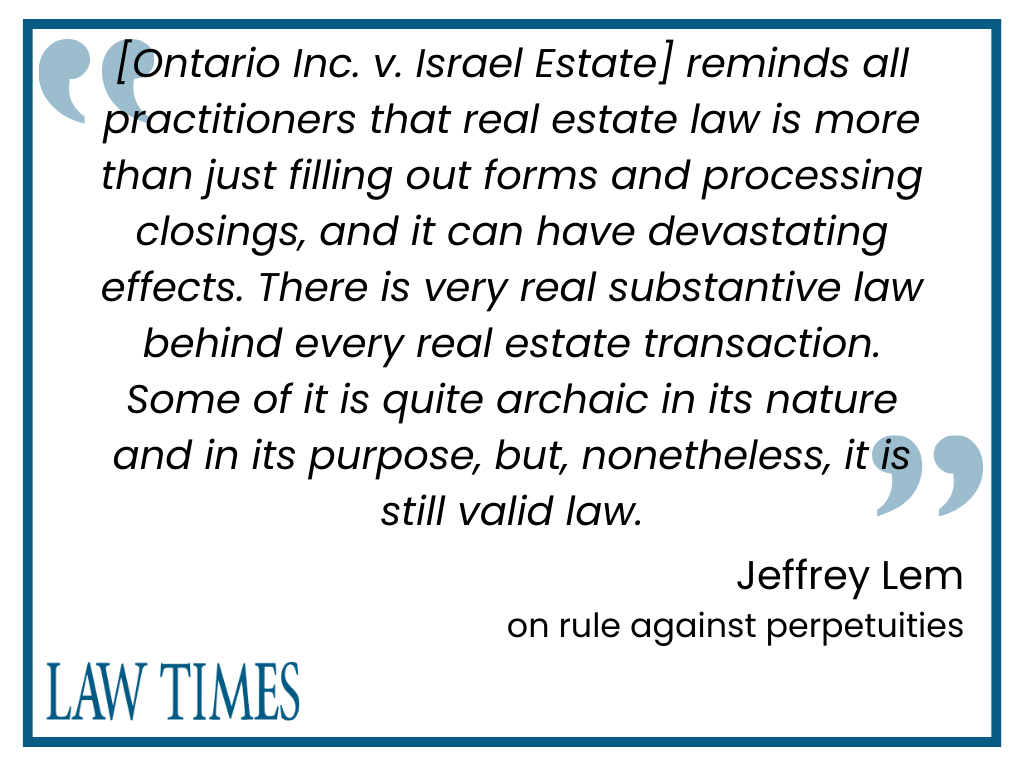
Learn about the Canadian laws on the rule against perpetuities, and if it’s still relevant to real estate transfers in Ontario

Updated Sep 19, 2024
The rule against perpetuities might sound like a complicated legal term, but it’s an important concept in estate planning and real estate law. While it’s a difficult legal concept to understand, it’s still very much alive in Canada’s laws, specifically in Ontario. As such, it’s necessary for lawyers, especially in the field of real estate and trusts and estate, to have a good grasp of this rule.
The rule against perpetuities says that a person’s interests (i.e., contingent or future interest) in a property must vest, if at all, within or not later than 21 years, after the death of a life-in-being at the time that the interest was created. It is a common law doctrine that applies to most jurisdictions, while some even enacted it into a statute.
It limits the power of property owners when they designate who can enjoy the beneficial ownership of the subject property in the future. In some sense, it limits how long a property owner can control the transfer of their property after death.
Here’s another definition of the rule: it prevents the property owner’s delay to vest many types of transferred property interests beyond the perpetuity period. Meaning, the limit must only be within the perpetuity period. This period starts during the creation of the interest, which can be computed by combining the life of the "lives-in-being" plus 21 years. It usually starts when an instrument (e.g., deed, or will) takes effect.
The lives-in-being are the people alive at the time when the interest was created. It is only after the death of the life-in-being that the 21 years will start to run, but this may be limited or expanded by law in other jurisdictions.
Watch this video for a visual explanation about what is the rule against perpetuities:
To know more about the rule against perpetuities, consult a top-ranking lawyer in your area. Check out Canadian Lawyer Mag’s Special Report on the Top Law Firms in Ontario.
Contrary to the usual perception among real estate lawyers, Canadian law recognizes — and implements — the rule against perpetuities. In Ontario, common law and the provincial statute on the Perpetuities Act (the Act) are the governing laws on the rule against perpetuities.
The rule against perpetuities is highly relevant to lawyers who are practicing the legal areas of:
As to their clients, the following persons and transactions may be covered by the rule:
The purpose of this rule is to prevent property owners from still controlling the transfer and the enjoyment of their conveyed properties after they have long been dead. Simply stated, it prevents a “dead hand control” over the property by its previous owner.
On the side of the person who has interest in the property, it allows them to convey (i.e., sell or transfer) the property to another beyond the perpetuity period. The rule ensures that a new or future owner can eventually decide what happens to the property, free from any restrictions imposed by the previous owner, such as their ancestors.
“There is a very real substantive law behind every real estate transaction. Some of it is quite archaic in its nature and in its purpose, but, nonetheless, it is still valid law,” said Jeffrey Lem, the Director of Titles for the province of Ontario. One of these laws that real estate lawyers must be aware of is the rule against perpetuities. “Indeed, it is unlikely that there are more than a few practitioners that can comfortably discuss the rule.”
The California case of Lucas v. Hamm, 56 Cal. 2d 583, 364 P. 2d 685, would not probably be a defence against professional negligence in Canada, as pointed out by Lem. “[T]he rest of us are left desperately clinging to the comfort afforded us in Lucas v. Hamm. That’s the California case that excused a lawyer from professional negligence over a mistake because, according to the court, the rule was just too complicated for the average lawyer to possibly ever comprehend.”
The defence afforded by Lucas v. Hamm proved to be ineffective in Ontario, as seen in the Ontario Court of Appeal decision in 2123201 Ontario Inc. v. Israel Estate, 2016 ONCA 409. “The case reminds us that the rule is alive and well, at least in Ontario, and can have significant consequences for real estate conveyances unaware of its impact,” said Lem.
The Israel Estate case and the 2021 case of ClubLink Corporation are just some of the important and relevant court rulings applying the rule against perpetuities.
In 1931, an owner sold a gravel quarry to operators who immediately granted an option back to the owner allowing the owner to reacquire the property. This option was:
Nearly 85 years later, the gravel operators’ successors reneged on their obligations under the option. Instead, they argued that once the gravel had been depleted, the original owner had no right to reacquire the property pursuant to the option. This is because the rights under that option are void by operation of the rule against perpetuities.
The Court of Appeal agreed with the operators and concluded that the rule applied in Israel Estate. Accordingly, the original owner’s re-acquisition rights were contingent upon the gravel being depleted by 2001. This did not happen, so his rights did not vest within the cut-off period, and the option was, therefore, rendered void by operation of the rule.
“The rule was very much alive and well in Ontario and practitioners were to ignore it at their own peril,” said Lem. Applying the rule to Israel Estate, Lem explained that the option would be void unless it could be proven that the gravel was depleted before 2001, which was 21 years after the owner's death.
“The continued applicability of the rule as part of Ontario law was undisputed, and the case turned on the nature of the option agreement itself,” Lem said. This is because the agreement was an unusual instrument, and the Court of Appeal had to first determine whether it purported to create an interest in land. If the option agreement did create an interest in land, then that interest in land was subject to the rule.
Lem gave some insights on how the result of the case would have been different. “If the option agreement did not create an interest in land (and was more of a personal right such as a right of first refusal), then it might have survived the ravages of the rule.
“Israel Estate reminds all practitioners that real estate law is more than just filling out forms and processing closings, and it can have devastating effects,” said Lem.

A recent case in Ontario on the rule against perpetuities is the case of Ottawa (City) v. ClubLink Corporation ULC, 2021 ONCA 847. In a dispute between ClubLink and the City of Ottawa, the issue is whether the golf course land acquired by ClubLink should be transferred back to the City based on their 1981 agreement.
ClubLink wanted to convert the use of the golf course land because of the decline of its membership in 2019. However, the City contended that it must be transferred back to them instead, relying on the transfer provisions of the 1981 agreement. ClubLink countered the City’s argument using the rule against perpetuities, which had lapsed in 2002 if the rule is applied.
In finding for ClubLink, the Court of Appeal said that conditional interest in the land warranted the application of the rule against perpetuities. As such, the transfer provisions were void because the City’s right to demand the transfer of the golf course lands did not occur within the rule’s 21-year period.
The rule against perpetuities simply means that a conditional interest in a property must be completed or realized within 21 years after a certain time, such as the life-in-being.
Here’s how the rule works under common law when it comes to the subject property and the parties involved in the property:
Here’s a video to help explain this seemingly complicated rule:
The rule against perpetuities may also apply to properties involved in trusts and estates. More resources can be found on our Trusts and Estates page.
The provinces of Alberta, British Columbia, and Ontario have used the “wait-and-see” version of the rule against perpetuities. Here, the rule is not automatically violated when the estate or interest:
Instead, the interest or condition will be presumed valid, and parties would have to wait and see if the rule is violated in the future.
In Ontario, this rule is codified in s. 4(1) of the provincial Perpetuities Act. It states that every contingent interest in a property, which is vested within or beyond the perpetuity period, is presumptively valid until actual events establish the following:
All the Perpetuities Act did was to modify the common law to fit the more progressive wait-and-see rule, according to Lem. “At pure common law, the option agreement in Israel Estate would have been void ab initio, simply because there was a possibility that the gravel would not be depleted by 2001.”
In contrast, “[u]nder a wait-and-see modification of the rule, the option agreement was contingently valid until 2001 (21 years after the owner’s life). However, it became void immediately after the vesting trigger (i.e., the depletion of gravel on the property) had not occurred.”
No matter how hard we label the rule against perpetuities as archaic and impossible to understand, it’s still a very valid law in Canada, specifically in Ontario. It’s important that members of a family or parties in a real estate transaction understand the rule. This ensures harmonious dealings between these interested people, not only now, but also in the future.
For more information on real estate rules other than the rule against perpetuities, bookmark our page on the practice area of Real Estate.
A contributor to this article, Jeffrey Lem, is the Director of Titles for Ontario. Part of this article reflects the personal views of the author alone.